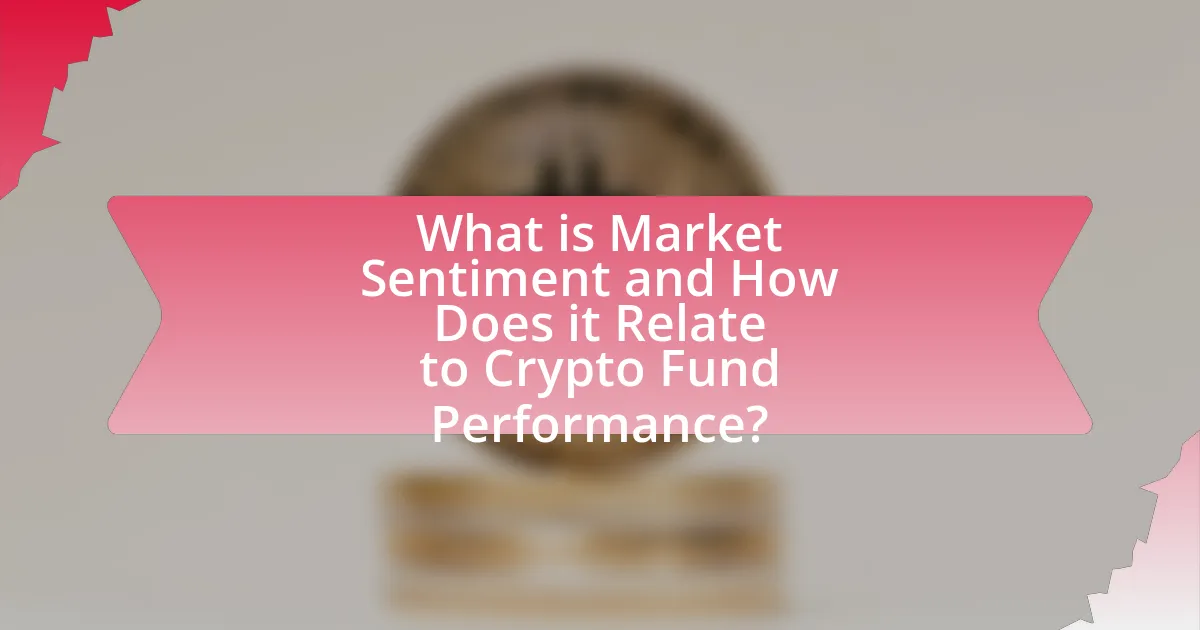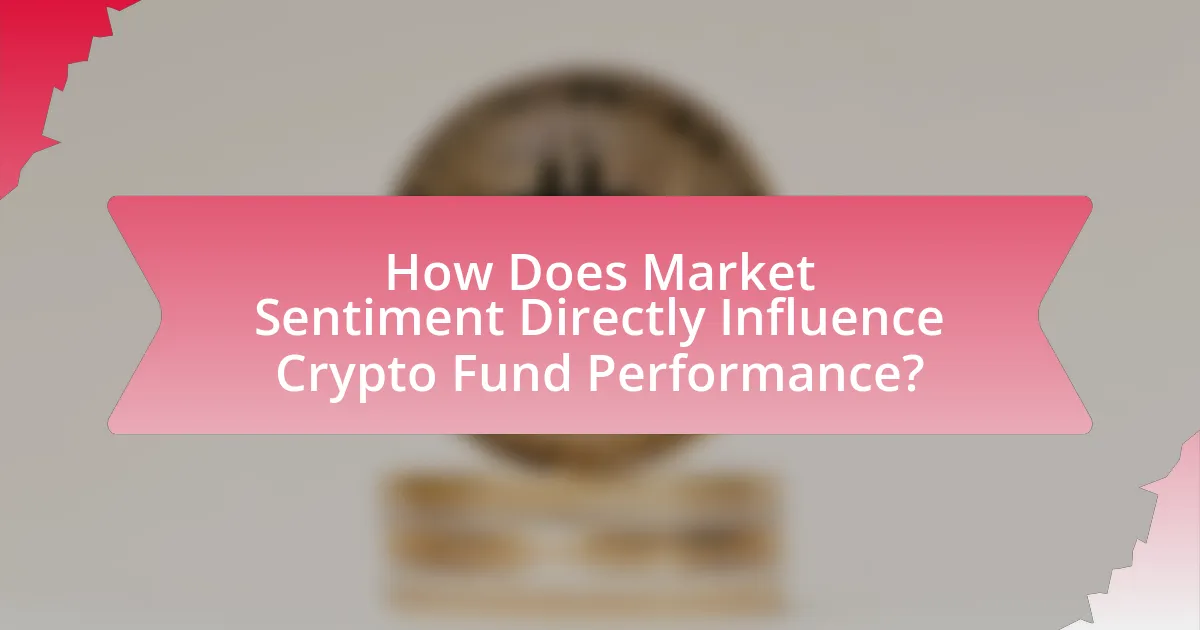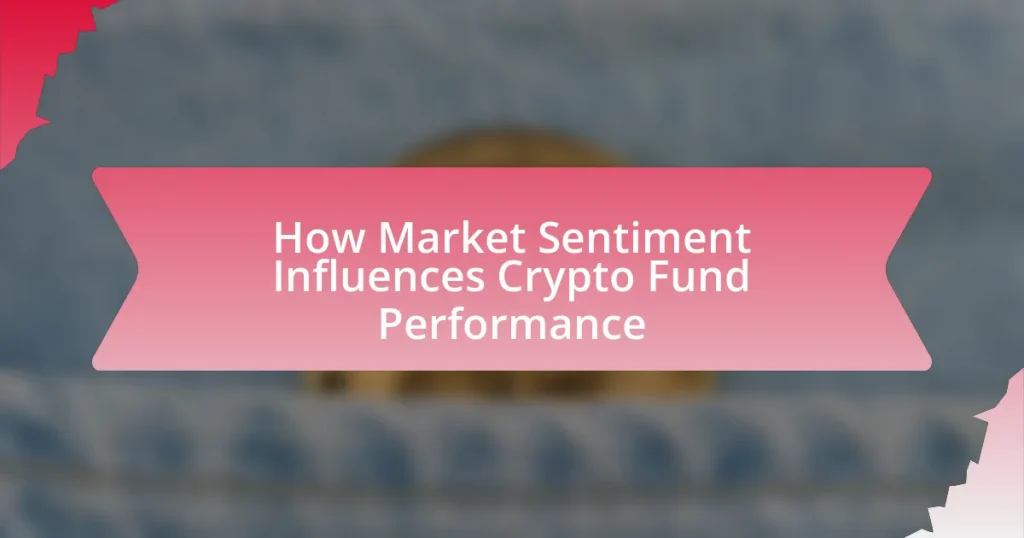Market sentiment is the overall attitude of investors toward a specific market or asset, significantly impacting the performance of crypto funds. This article explores how market sentiment influences investment decisions, leading to price fluctuations and volatility in cryptocurrencies. It examines the factors that shape market sentiment, the differences between cryptocurrency and traditional market sentiment, and the importance of understanding sentiment for fund managers. Additionally, it discusses the key indicators of market sentiment, the role of social media, and the risks associated with relying on sentiment for investment decisions. The article concludes with best practices for crypto fund managers to effectively monitor and leverage market sentiment to enhance fund performance.

What is Market Sentiment and How Does it Relate to Crypto Fund Performance?
Market sentiment refers to the overall attitude of investors toward a particular market or asset, reflecting their feelings and perceptions about its future performance. In the context of crypto fund performance, market sentiment significantly influences investment decisions, leading to price fluctuations and volatility in cryptocurrencies. For instance, positive sentiment can drive increased investment in crypto funds, resulting in higher asset prices, while negative sentiment may lead to sell-offs and decreased fund performance. Historical data shows that during bullish market phases, such as the 2017 cryptocurrency boom, investor optimism led to substantial inflows into crypto funds, whereas bearish phases, like the 2018 market downturn, saw significant withdrawals and declining fund values. Thus, understanding market sentiment is crucial for predicting and analyzing the performance of crypto funds.
How is market sentiment defined in the context of cryptocurrency?
Market sentiment in the context of cryptocurrency is defined as the overall attitude of investors toward a particular cryptocurrency or the market as a whole. This sentiment is often gauged through various indicators such as trading volume, price movements, social media activity, and news coverage. For instance, a surge in positive news about a cryptocurrency can lead to increased buying activity, reflecting bullish sentiment, while negative news can trigger selling, indicating bearish sentiment. Studies have shown that market sentiment can significantly influence price fluctuations, as seen during events like the 2017 Bitcoin boom, where heightened investor enthusiasm drove prices to unprecedented levels.
What factors contribute to the formation of market sentiment?
Market sentiment is primarily influenced by factors such as news events, social media trends, investor behavior, and economic indicators. News events, including regulatory announcements or technological advancements, can rapidly shift perceptions and expectations among investors. Social media trends amplify these sentiments, as platforms like Twitter and Reddit allow for real-time discussions and reactions, often leading to herd behavior. Investor behavior, characterized by fear and greed, also plays a crucial role; for instance, during market downturns, fear can lead to panic selling, while optimism can drive prices up. Economic indicators, such as inflation rates and employment data, provide context that shapes investor confidence and market outlook. Collectively, these factors create a dynamic environment where market sentiment can change swiftly, impacting crypto fund performance significantly.
How does market sentiment differ from traditional market sentiment?
Market sentiment in the context of cryptocurrencies differs from traditional market sentiment primarily due to the volatility and speculative nature of digital assets. Traditional market sentiment is often influenced by established economic indicators, corporate earnings, and geopolitical events, whereas cryptocurrency market sentiment is heavily driven by social media trends, community engagement, and technological developments. For instance, a study by the University of Technology Sydney found that social media sentiment significantly impacts cryptocurrency prices, highlighting the unique factors that shape market perceptions in the crypto space compared to traditional markets.
Why is understanding market sentiment crucial for crypto fund managers?
Understanding market sentiment is crucial for crypto fund managers because it directly influences investment decisions and portfolio performance. Market sentiment reflects the overall attitude of investors toward a particular cryptocurrency or the market as a whole, which can lead to significant price fluctuations. For instance, a study by the University of California, Berkeley, found that positive sentiment can drive prices up, while negative sentiment can lead to sharp declines, impacting fund returns. By analyzing sentiment through social media trends, news articles, and market indicators, fund managers can make informed decisions that align with prevailing investor emotions, ultimately enhancing their ability to capitalize on market movements.
What role does market sentiment play in investment decision-making?
Market sentiment significantly influences investment decision-making by shaping investors’ perceptions and behaviors regarding asset value. When market sentiment is positive, investors are more likely to buy assets, driving prices up; conversely, negative sentiment can lead to selling pressure and declining prices. Research indicates that sentiment indicators, such as the Fear and Greed Index, can predict market movements, demonstrating that emotional factors often outweigh fundamental analysis in short-term trading. For instance, during the 2017 cryptocurrency boom, heightened optimism led to unprecedented investment inflows, while subsequent downturns were largely driven by fear and panic selling.
How can market sentiment impact fund performance metrics?
Market sentiment significantly impacts fund performance metrics by influencing investor behavior and decision-making. When market sentiment is positive, investors are more likely to buy into funds, driving up asset prices and improving metrics such as returns and net asset value. Conversely, negative sentiment can lead to sell-offs, decreasing fund performance metrics due to falling asset prices and increased redemption rates. For instance, during the 2021 cryptocurrency bull market, positive sentiment led to substantial inflows into crypto funds, resulting in average returns exceeding 200%. In contrast, during the 2018 bear market, negative sentiment caused many funds to report losses, with some experiencing declines of over 80%. These examples illustrate how market sentiment directly correlates with fund performance metrics.
What are the key indicators of market sentiment in the crypto space?
Key indicators of market sentiment in the crypto space include trading volume, price volatility, social media activity, and market dominance of major cryptocurrencies. Trading volume reflects the level of interest and participation in the market, with higher volumes often indicating bullish sentiment. Price volatility measures the degree of price fluctuations, where increased volatility can signal uncertainty or speculative behavior among investors. Social media activity, particularly on platforms like Twitter and Reddit, provides insights into public sentiment and trends, as discussions and mentions can influence market movements. Lastly, market dominance, particularly of Bitcoin, serves as an indicator of overall market health; a higher dominance often correlates with positive sentiment towards the crypto market as a whole. These indicators collectively help gauge the prevailing mood and expectations of investors in the cryptocurrency landscape.
How do social media trends influence market sentiment?
Social media trends significantly influence market sentiment by shaping public perception and investor behavior. For instance, platforms like Twitter and Reddit can amplify discussions around specific cryptocurrencies, leading to rapid shifts in sentiment. A notable example is the impact of the “Dogecoin” trend on its price, where social media buzz contributed to a surge in interest and investment, resulting in a price increase of over 800% in early 2021. This demonstrates that social media can create a feedback loop where positive sentiment drives investment, further enhancing market activity.
What technical indicators can signal changes in market sentiment?
Technical indicators that can signal changes in market sentiment include the Relative Strength Index (RSI), Moving Average Convergence Divergence (MACD), and Bollinger Bands. The RSI measures the speed and change of price movements, indicating overbought or oversold conditions, which can reflect shifts in investor sentiment. The MACD, by analyzing the relationship between two moving averages, helps identify momentum changes that often precede sentiment shifts. Bollinger Bands provide insights into market volatility and potential price reversals, as price movements outside the bands can indicate extreme sentiment. Historical data shows that these indicators have effectively predicted market sentiment changes in various trading scenarios, reinforcing their reliability in assessing investor behavior.

How Does Market Sentiment Directly Influence Crypto Fund Performance?
Market sentiment directly influences crypto fund performance by affecting investor behavior and decision-making. When market sentiment is positive, investors are more likely to buy cryptocurrencies, leading to increased demand and higher prices, which can enhance the performance of crypto funds. Conversely, negative sentiment can trigger sell-offs, resulting in decreased prices and poor fund performance. For instance, during the 2021 bull market, positive sentiment driven by institutional adoption and media coverage led to significant inflows into crypto funds, with assets under management reaching record highs. In contrast, the 2018 bear market, characterized by negative sentiment and regulatory concerns, saw many crypto funds experience substantial losses. Thus, market sentiment serves as a critical driver of both inflows and outflows, directly impacting the overall performance of crypto funds.
What are the mechanisms through which market sentiment affects fund performance?
Market sentiment affects fund performance primarily through investor behavior, asset pricing, and market volatility. Investor behavior is influenced by sentiment, leading to herd behavior where investors buy or sell based on collective emotions rather than fundamentals. This can result in price bubbles or crashes, impacting fund performance. Asset pricing is affected as positive sentiment can inflate asset values, while negative sentiment can lead to undervaluation, directly influencing the returns of funds holding those assets. Additionally, market volatility, driven by sentiment shifts, can create unpredictable environments that challenge fund managers’ strategies, ultimately affecting performance metrics. Historical data shows that during periods of high sentiment, such as the 2017 cryptocurrency boom, funds often experienced significant inflows and returns, while downturns, like the 2018 market correction, led to substantial losses, illustrating the direct correlation between sentiment and fund performance.
How do investor emotions translate into market movements?
Investor emotions significantly influence market movements by driving buying and selling decisions, which in turn affect asset prices. When investors feel optimistic, they are more likely to buy, leading to price increases; conversely, fear or pessimism can trigger selling, resulting in price declines. Research indicates that emotional factors such as fear and greed can lead to market volatility, as seen during events like the 2008 financial crisis, where panic selling caused sharp declines in stock prices. Additionally, studies show that sentiment indicators, such as the Fear & Greed Index, correlate with market trends, demonstrating that collective investor emotions can create substantial shifts in market dynamics.
What is the relationship between market sentiment and volatility in crypto funds?
Market sentiment significantly influences volatility in crypto funds, as positive sentiment often leads to increased buying activity, while negative sentiment can trigger selling pressure. This relationship is evidenced by the correlation between sentiment indicators, such as the Fear and Greed Index, and price fluctuations in cryptocurrencies. For instance, during periods of heightened optimism, volatility tends to decrease as prices stabilize, whereas in times of fear, volatility increases due to rapid price swings driven by panic selling. Historical data shows that major market events, such as regulatory announcements or technological advancements, can shift sentiment dramatically, resulting in corresponding spikes in volatility within crypto funds.
How can crypto funds leverage market sentiment for better performance?
Crypto funds can leverage market sentiment for better performance by utilizing sentiment analysis tools to gauge investor emotions and trends. By analyzing social media, news articles, and trading volumes, these funds can identify bullish or bearish sentiments that may influence price movements. For instance, a study by the University of California, Berkeley, found that social media sentiment significantly correlates with cryptocurrency price changes, indicating that positive sentiment can lead to price increases. By aligning their trading strategies with prevailing market sentiments, crypto funds can enhance their decision-making processes and optimize returns.
What strategies can fund managers employ to align with market sentiment?
Fund managers can employ strategies such as sentiment analysis, adaptive asset allocation, and active communication to align with market sentiment. Sentiment analysis involves using data from social media, news articles, and market trends to gauge investor emotions and expectations, allowing fund managers to make informed investment decisions. Adaptive asset allocation enables fund managers to adjust their portfolios based on prevailing market sentiment, shifting investments towards assets that are favored during bullish periods and away from those that are underperforming in bearish conditions. Active communication with investors helps fund managers to manage expectations and provide insights into market conditions, fostering trust and alignment with investor sentiment. These strategies are supported by research indicating that funds utilizing sentiment analysis can outperform their benchmarks by effectively anticipating market movements.
How can sentiment analysis tools enhance fund performance?
Sentiment analysis tools enhance fund performance by providing insights into market sentiment, which can inform investment decisions. These tools analyze social media, news articles, and other data sources to gauge public perception and emotional reactions towards specific assets or the market as a whole. For instance, a study by Bollen et al. (2011) demonstrated that Twitter sentiment could predict stock market movements, indicating that positive sentiment correlates with price increases. By leveraging sentiment analysis, fund managers can identify trends, anticipate market shifts, and make data-driven decisions that align with investor sentiment, ultimately leading to improved fund performance.
What are the risks associated with relying on market sentiment?
Relying on market sentiment poses several risks, including volatility, herd behavior, and misinformation. Market sentiment can lead to rapid price fluctuations, as seen during events like the 2017 cryptocurrency boom, where prices surged based on speculative enthusiasm rather than fundamental value. This volatility can result in significant financial losses for investors who follow trends without thorough analysis. Additionally, herd behavior often causes investors to make decisions based on the actions of others rather than their own research, which can exacerbate market bubbles and crashes. Misinformation, prevalent in the crypto space, can further distort sentiment, leading to misguided investment decisions. For instance, false news can trigger panic selling or irrational buying, impacting fund performance negatively.
How can overreliance on sentiment lead to poor investment decisions?
Overreliance on sentiment can lead to poor investment decisions by causing investors to make choices based on emotional reactions rather than fundamental analysis. This emotional decision-making often results in buying high during market euphoria or selling low during panic, which can significantly diminish returns. For instance, a study by the University of California, Berkeley, found that investors who followed market sentiment trends often underperformed the market by as much as 5% annually due to these impulsive actions. Thus, relying heavily on sentiment can distort rational investment strategies and lead to suboptimal financial outcomes.
What are the potential pitfalls of misinterpreting market sentiment?
Misinterpreting market sentiment can lead to significant financial losses and misguided investment strategies. Investors may make decisions based on inaccurate perceptions, resulting in buying high during market euphoria or selling low during panic. For instance, during the 2017 cryptocurrency boom, many investors misread the market’s exuberance as a long-term trend, leading to substantial losses when prices corrected sharply in 2018. Additionally, misinterpretation can cause a herd mentality, where individuals follow the crowd rather than conducting independent analysis, further exacerbating market volatility. This behavior can distort asset valuations and create bubbles, ultimately harming overall market stability.

What Best Practices Should Crypto Fund Managers Follow Regarding Market Sentiment?
Crypto fund managers should actively monitor and analyze market sentiment to make informed investment decisions. By utilizing sentiment analysis tools and social media monitoring, managers can gauge public perception and trends that may impact asset prices. For instance, a study by the University of California, Berkeley, found that social media sentiment significantly correlates with cryptocurrency price movements, indicating that positive or negative sentiment can lead to substantial market shifts. Additionally, maintaining a diversified portfolio can help mitigate risks associated with sudden changes in market sentiment, as evidenced by research from the CFA Institute, which highlights that diversification reduces volatility and enhances returns.
How can fund managers effectively monitor market sentiment?
Fund managers can effectively monitor market sentiment by utilizing a combination of quantitative data analysis, social media sentiment analysis, and market indicators. Quantitative data analysis involves tracking price movements, trading volumes, and volatility indices, which provide insights into market trends and investor behavior. Social media sentiment analysis leverages natural language processing tools to gauge public sentiment from platforms like Twitter and Reddit, where discussions about cryptocurrencies are prevalent. Additionally, market indicators such as the Fear and Greed Index can help fund managers assess overall market sentiment by quantifying emotions driving market movements. These methods collectively enable fund managers to make informed decisions based on real-time sentiment data, enhancing their ability to navigate the volatile crypto market effectively.
What tools and resources are available for sentiment analysis?
Sentiment analysis can be conducted using various tools and resources, including natural language processing libraries, APIs, and platforms. Popular tools include NLTK (Natural Language Toolkit), which provides libraries for text processing and sentiment classification; TextBlob, known for its simplicity in performing sentiment analysis; and VADER (Valence Aware Dictionary and sEntiment Reasoner), specifically designed for social media text. Additionally, cloud-based APIs like Google Cloud Natural Language and IBM Watson offer robust sentiment analysis capabilities. These tools are widely used in the industry, demonstrating their effectiveness in analyzing market sentiment, which is crucial for understanding influences on crypto fund performance.
How often should fund managers reassess market sentiment?
Fund managers should reassess market sentiment at least on a weekly basis. This frequency allows them to stay attuned to rapid changes in investor behavior and market dynamics, which are particularly volatile in the cryptocurrency sector. Research indicates that market sentiment can shift dramatically within short time frames, impacting asset prices and fund performance. For instance, a study by the University of California, Berkeley, found that sentiment analysis can predict price movements in cryptocurrencies with a correlation coefficient of 0.75, underscoring the importance of regular reassessment.
What are the common mistakes to avoid when interpreting market sentiment?
Common mistakes to avoid when interpreting market sentiment include over-reliance on social media trends, misreading short-term fluctuations as long-term trends, and ignoring fundamental analysis. Over-reliance on social media can lead to skewed perceptions, as platforms often amplify extreme opinions rather than reflect balanced views. Misreading short-term fluctuations can result in hasty decisions; for instance, a sudden price drop may not indicate a fundamental shift but rather market noise. Ignoring fundamental analysis can cause investors to overlook critical factors such as project viability and market conditions, which are essential for informed decision-making. These mistakes can significantly impact investment strategies and outcomes in the volatile crypto market.
How can biases affect the interpretation of market sentiment?
Biases can significantly distort the interpretation of market sentiment by leading investors to misjudge the emotional and psychological factors driving market movements. For instance, confirmation bias may cause investors to favor information that aligns with their existing beliefs about a cryptocurrency, ignoring contrary data that could indicate a shift in sentiment. Research by the CFA Institute highlights that cognitive biases, such as overconfidence and herd behavior, can lead to mispricing in financial markets, ultimately affecting investment decisions and fund performance. This misinterpretation can result in poor investment choices, as investors may react to sentiment indicators based on flawed perceptions rather than objective analysis.
What strategies can mitigate the impact of emotional decision-making?
To mitigate the impact of emotional decision-making, investors can implement strategies such as establishing clear investment goals, utilizing data-driven analysis, and employing risk management techniques. Establishing clear investment goals helps investors maintain focus and reduces impulsive reactions to market fluctuations. Data-driven analysis, including technical and fundamental analysis, provides objective insights that counteract emotional biases. Additionally, employing risk management techniques, such as setting stop-loss orders and diversifying portfolios, can protect against significant losses driven by emotional responses. These strategies are supported by research indicating that structured decision-making processes lead to better investment outcomes, as evidenced by studies showing that disciplined investors outperform those who react emotionally to market changes.
What practical tips can enhance a crypto fund’s performance through market sentiment?
To enhance a crypto fund’s performance through market sentiment, fund managers should actively monitor social media trends and sentiment analysis tools. By analyzing platforms like Twitter and Reddit, managers can gauge public sentiment and identify potential market movements. For instance, a study by the University of Technology Sydney found that social media sentiment significantly correlates with Bitcoin price fluctuations, indicating that positive sentiment can lead to price increases. Additionally, employing sentiment analysis algorithms can provide quantitative insights, allowing fund managers to make informed investment decisions based on prevailing market emotions.
How can diversification help in managing sentiment-driven risks?
Diversification helps in managing sentiment-driven risks by spreading investments across various assets, which reduces the impact of negative sentiment on any single asset. When market sentiment shifts, certain assets may experience significant price fluctuations due to emotional reactions from investors. By holding a diversified portfolio, the adverse effects on one asset can be mitigated by the stability or performance of others. For instance, during periods of market panic, a diversified portfolio may include assets that are less correlated with the overall market, thereby cushioning the portfolio against drastic losses. Historical data shows that diversified portfolios tend to exhibit lower volatility compared to concentrated investments, demonstrating that diversification is an effective strategy for risk management in sentiment-driven environments.
What role does continuous education play in understanding market sentiment?
Continuous education is essential for understanding market sentiment as it equips investors with the latest knowledge and analytical skills necessary to interpret market trends effectively. By staying informed about economic indicators, technological advancements, and behavioral finance, investors can better gauge public perception and emotional responses to market events. Research indicates that informed investors are more adept at recognizing sentiment shifts, which can significantly impact asset prices, particularly in volatile markets like cryptocurrency. For instance, a study by the CFA Institute highlights that continuous learning enhances decision-making capabilities, allowing investors to respond proactively to market sentiment changes, thereby improving fund performance.















